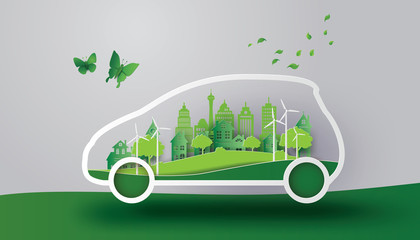Evolution of Electric Cars
Back in 1900, electric cars made-up 28% of total car sales in the US. Over the next two decades, electric cars gained popularity, however customer aspirations to cover longer distances in an electric car became a barrier to their mainstream adoption. Alongside this, Henry Ford’s mass production of combustion engine cars (1920), made gasoline cars substantially cheaper than electric cars. This led to the sudden decline of the popularity of electric cars, and within the next 20 years, the electric car was almost forgot by consumers. Gasoline cars saw dramatic growth, such that 500 million cars were on the roads by 1986.
The increase in the population of gasoline cars inevitably caused an increase in Co2 emissions, leading to the deterioration of the environment. As a result, clean air acts were introduced by various governments, coupled with backing of research and development projects for alternative-fueled cars. Following electric vehicle technology advancements over the next few decades, the Toyota Prius became global in 2000, becoming one of the first mass-produced hybrid-electric vehicles, selling 50,000 units in its first year.
Electric Vehicles really rose to prominence in 2006 with the introduction of Tesla’s plan to launch a battery powered car with a range of 200 miles in 2006. In the year 2017 itself, global electric vehicle sales until August were over 649 000 units, 46% higher than the same period in 2016.
The surge in electric vehicles is a result of the current stringent regulatory Co2 emission norms that have obligated automotive manufacturers to step up their game and prioritise electric car projects. The next section of the article illustrates why the adoption of electric cars on a mainstream scale is not a choice but a compulsion.
Apple and Tesla, is the iPhone maker really planning to buy the car company?
Electric car is not a choice now, but compulsion
The latest trends in the automotive industry and the political climate is accentuating the priority of electric car projects both in developed and developing countries. Tax exemption, subsidies, grants to manufacturers and consumers and the subsequent announcement of the bans on the production of gasoline cars show how governments and regulatory bodies take the seriousness of the electric car. National Grid has estimated that up to 26 million electric vehicles will be on the road by 2050, (Elmhirst, “Our Energy Insights – Forecourt thoughts: Mass fast charging of electric vehicles (National Grid),” 2017.) and may become the most favorable option in the consumer mind across the global markets. The underpinning factors supporting the future electric car boom can be further detailed into 4 fundamental dimensions:
Co2 emissions:
Road transport running on gasoline engines contributes to 16% of total Co2 emission11, causing the deterioration of environment:
• Air Pollution: Over 5.5 million deaths a year are linked to Air pollution. Air pollution has been the main cause of health issues like lung cancer, asthma and cardiovascular diseases. Vehicle emissions kill more people in the UK than auto accidents.
• Global Warming: Reduction in the availability of fresh water. Temperature rise and increase in hurricanes and droughts.
• Ocean Acidification: Co2 dissolving in ocean water makes the water acidic and impacts the marine life.
Economy revival:
The shift to electric mobility can be viewed as an opportunity to revive some of the world’s largest economies.
• Air pollution caused from road transport and its negative health effects costs OECD countries approximately $1 trillion a year.
• Europe in particular depends heavily on oil, exporting €525m daily in return for oil, equating to 1-1.5% of the EU’s GDP5. Employment intensity is low in oil and distribution, hence, conveying the expenditure from purchasing imported oil to other avenues creates employment opportunities.
• Statistics suggest that by 2050, the shift in electric cars will create up to 2 million jobs and lead to a 1% increase in the EUs GDP5. Job creation will also incur in other economies adopting electric vehicles through the requirement of research and development and the increase in start-ups.
Electric vehicles open new avenues for smart cities
Decline in cost of ownership:
• Maintenance Costs: An electric motor comprises of only 3 moving parts, in comparison to the 1000 in a gasoline engine. Electric vehicles diminish the likelihood of a breakdown and reduce the need for spare parts by 60% according to UBS.
• Efficiency: ICEs convert around 17-21% of stored energy stored in gasoline to power the wheels. Electric vehicles convert between 59% – 62% of the electric energy from the grid power to the wheels.
• Mass production: Manufacturers racing for market share in the electric car market are beginning to mass produce a larger, more affordable range of electric vehicles. In addition to this, battery costs have reduced by 65% since 2010 due to increased efficiency in battery manufacturing and economies of scale as electric vehicles become more popular.
• Government subsidies and Incentives: Many governments are promoting electric cars to the end consumers by offering tax rebates, grants on vehicle purchase, other privileges such as toll free travel, free parking etc.
Fossil fuel depletion
Predictions on fossil fuel reserves indicate that around 115 years of coal production remain, and approx. 50 years of both oil and natural gas remain. Therefore, it is crucial to consider alternative methods of running cars.
Potential road blockers in electric car journey
Despite the mammoth growth in the number of electric vehicles on the road, the ride to the global adoption of electric vehicles is not expected to be smooth, as there are many hurdles which need to be overcome. Some of the challenges which are in need of addressing are highlighted below:
Surge in electricity demand
Charging the forecasted number of 2 billion electric vehicles will inevitably cause a mammoth demand for electricity. Due to this, the demand for crude oil will go down. Therefore, the most favorable option for Power grid companies would be to use oil as a source of producing electricity. Hence, electric cars will indirectly contribute to the generation of Co2 emissions.
Battery recycling
11m tons of spent lithium-ion batteries are expected to be in need of recycling between now and 2030. At present, only 5% of lithium-ion batteries are being recycled in the EU, increasing the number of waste.
Charging infrastructure
The lack of charging stations are proving to be a monumental factor in preventing the adoption of electric cars. At present, in the US around 16,000 charging stations are installed, with the majority of these providing a slow charge. Accessibility, speed and convenience are challenges which need to be addressed when developing the electric vehicle charging infrastructure.
Battery technology
With the increasing demand of electric cars, automotive manufacturers are being faced with a scarcity of cobalt and lithium. The current shortage of lithium has seen prices double since 2015, and it is estimated that in order to electrify the global fleet of vehicles, lithium production needs to increase.
Customer adoption
The electric car disruption may be difficult for some consumers to comprehend. Furthermore, range anxiety, battery lifetime, charging station availability and the initial cost of purchase are just some of the factors which could prevent customers from accepting and purchasing electric cars.
In addition to addressing these challenges, in order to be able to meet the forecasted consumer demand for electric vehicles, automotive manufacturers will have to make substantial changes to their current operations. The following section, ‘Electric car impact on automotive value chain’, details out the kind of changes that will be taking place in the various functions.
Breakthrough technology will recharge electric cars faster than regular vehicles refuel
Electric car impact on automotive value chain
Embracing the future of electric cars is not only a big step for consumers, but is also a monumental change for
automotive manufacturers. Manufacturing a brand new power train will ultimately require a revision of their current business models.
Product Development:
Research and Development:
Manufacturers will have to invest heavily into research and development, as customer requirements in an emerging market may be unclear.
Battery Technology:
Many manufacturers may choose to opt for in-house development and manufacturing of batteries
Manufacturing:
Assembly Line Simplification:
A decrease in parts will lead to a simplification of the vehicle assembly line.
Vertical Integration:
In house battery manufacturing
Quality Control:
Higher focus on quality control and auditing, as parts may be coming from new manufacturers
Testing:
Placing a greater emphasis on testing the vehicle due to the integration of new technology
Supply Chain:
New Suppliers:
Replacing traditional components with electric car specific elements may introduce new suppliers in the supply chain.
Battery Recycling:
Logistics to enable the shipment of used batteries to recycling facilities.
Sourcing components for battery manufacturing:
Manufacturers opting for in-house battery manufacturing will need to source the key elements e.g. Cobalt and lithium.
Customer Experience:
Service Repairs:
A decrease in the number of parts will reduce the number of service repairs.
Recharging Infrastructure:
Investment in recharging infrastructure
Warranty:
Battery warranty and replacement models will need to be implemented e.g. swapping, purchasing and leasing.
In addition to manufacturers experiencing changes to their business models and current work practices, consumers will also be facing a significant change in their current vehicle ownership experience. The traditional method of purchasing a car involves decisions such as choosing between a diesel or petrol engine and the engine size. However, replacing an engine with a battery will also substitute some of the traditional choices faced by the
consumers.
Battery Ownership v Leasing
Purchasing an electric vehicle is a substantial financial investment. However, new purchase models may offer the flexibility to purchase or lease a battery. Manufacturers such as Renault have already instilled schemes on certain electric vehicles, where consumers can buy the car, but lease the battery.
Battery Energy Storage Capacity
In an increasingly competitive market, manufacturers are innovating furiously to produce vehicles with the highest possible range. This leads to consumers being faced with the decision of purchasing a vehicle with a range most suitable to their commuting needs.
Digitalisation of vehicle distribution supply chain
In this piece, Munish Sharma from TCS UK & Ireland provides a detailed look at the Digitalisation of vehicle distribution supply chain. He considers RFID technology, IoT, mobility, analytics and autonomous vehicles.
A sneak peek into ‘a day in life of an electric car customer’ in a fully developed electric ecosystem
In a bid to tackle the consumer apprehension towards the charging infrastructure and range anxiety of electric cars, investment and innovation on electric car charging methods are on the increase. Electric car drivers are now being provided with an increasing number of options when it comes to charging their vehicle. Shell has revealed plans to install rapid chargers at their petrol stations, and consumers also have the option to charge their car in the comfort of their home through the use of home charging systems.
Ultimately, these charging facilities teamed with breakthrough technology will transform the vehicle ownership experience. Highlighted in the infographic below, we can see how these technologies will make electric vehicles a convenient option and what a day in the life of an electric car driver will look like.








Conclusion
Electric cars will be able to stand on their own feet, subject to four pieces of puzzle fitting together at some point. These puzzles are none other than vehicle charging infrastructure, price of battery fitting into customer’s pockets, improved vehicle mileage range and reduced cost of ownership.
About the Authors:
 Munish Sharma | Munish Sharma heads Customer Experience Management (CEM) value engine of the Innovation and Transformation Group at TCS UK & Ireland. He has over 17 years of automotive industry experience focusing on digital transformation of manufacturing industry.He completed his bachelors of engineering degree in Industrial production and certified supply chain consultant from Indian Institute of Technology (IIT), India. |
| Ayesha Rani is a digital consultant in Customer Experience Management (CEM) value engine of the Innovation and Transformation Group at TCS. She has completed her Management Studies (First Class Honours) from University of Leicester. |  Ayesha Rani Ayesha Rani |
|---|










